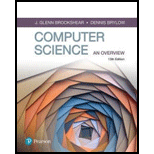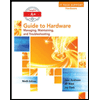
Concept explainers
- a. In what way are general-purpose registers and main memory cells similar?
- b. In what way do general-purpose registers and main memory cells differ?
a.
General-Purpose Registers:
General-Purpose registers are used to store the temporary data or memory location address. It holds the data for some time, but it does not store the data permanently. It holds the address or data till the next instruction is being executed.
Main memory:
Main memory is that physical memory where data and programs are stored when they are also being used by the processor. All the data and executed programs are copied from a storage device into main memory by the computer.
Explanation of Solution
Similarity between general-purpose registers and main memory:
General-Purpose registers are basically used to store the data and addresses. It holds the data for short duration.
Similarly, data is stored in main memory cells. The main memory is also used as storage device.
b.
General-Purpose Registers:
General-Purpose registers are used to store the temporary data or memory location address. It holds the data for some time, but it does not store the data permanently. It holds the address or data till the next instruction is being executed.
Main memory:
Main memory is that physical memory where data and programs are stored when they are also being used by the processor. All the data and executed programs are copied from a storage device into main memory by the computer.
Explanation of Solution
Difference between general-purpose registers and main memory:
| General purpose register | Main memory |
| These registers hold the data till the next instruction is being executed. | Main memory stores the data and instruction that is required in CPU for currently executing programs. |
| It is used for temporary storage device. | It is used for permanent storage of data in the device. |
| Register can hold data of 32-bits to 64-bits. | Main memory can store large amount of data from GB to TB. |
Want to see more full solutions like this?
Chapter 2 Solutions
Pearson eText for Computer Science: An Overview -- Instant Access (Pearson+)
Additional Engineering Textbook Solutions
Modern Database Management
Starting Out With Visual Basic (8th Edition)
Thinking Like an Engineer: An Active Learning Approach (4th Edition)
Java How to Program, Early Objects (11th Edition) (Deitel: How to Program)
Concepts Of Programming Languages
Mechanics of Materials (10th Edition)
- Ensure you answer the question asked at the end of the document. Do not just paste things without the GNS3 console outputsarrow_forward"Do not use AI tools. Solve the problem by hand on paper only and upload a photo of your handwritten solution."arrow_forward"Do not use AI tools. Solve the problem by hand on paper only and upload a photo of your handwritten solution."arrow_forward
- "Do not use AI tools. Solve the problem by hand on paper only and upload a photo of your handwritten solution."arrow_forward"Do not use AI tools. Solve the problem by hand on paper only and upload a photo of your handwritten solution."arrow_forwardSolve this "Do not use AI tools. Solve the problem by hand on paper only and upload a photo of your handwritten solution."arrow_forward
- "Do not use AI tools. Solve the problem by hand on paper only and upload a photo of your handwritten solution."arrow_forward"Do not use AI tools. Solve the problem by hand on paper only and upload a photo of your handwritten solution."arrow_forwardSpecifications: Part-1Part-1: DescriptionIn this part of the lab you will build a single operation ALU. This ALU will implement a bitwise left rotation. Forthis lab assignment you are not allowed to use Digital's Arithmetic components.IF YOU ARE FOUND USING THEM, YOU WILL RECEIVE A ZERO FOR LAB2!The ALU you will be implementing consists of two 4-bit inputs (named inA and inB) and one 4-bit output (named out). Your ALU must rotate the bits in inA by the amount given by inB (i.e. 0-15).Part-1: User InterfaceYou are provided an interface file lab2_part1.dig; start Part-1 from this file.NOTE: You are not permitted to edit the content inside the dotted lines rectangle. Part-1: ExampleIn the figure above, the input values that we have selected to test are inA = {inA_3, inA_2, inA_1, inA_0} = {0, 1, 0,0} and inB = {inB_3, inB_2, inB_1, inB_0} = {0, 0, 1, 0}. Therefore, we must rotate the bus 0100 bitwise left by00102, or 2 in base 10, to get {0, 0, 0, 1}. Please note that a rotation left is…arrow_forward
 Systems ArchitectureComputer ScienceISBN:9781305080195Author:Stephen D. BurdPublisher:Cengage Learning
Systems ArchitectureComputer ScienceISBN:9781305080195Author:Stephen D. BurdPublisher:Cengage Learning Principles of Information Systems (MindTap Course...Computer ScienceISBN:9781285867168Author:Ralph Stair, George ReynoldsPublisher:Cengage Learning
Principles of Information Systems (MindTap Course...Computer ScienceISBN:9781285867168Author:Ralph Stair, George ReynoldsPublisher:Cengage Learning C++ for Engineers and ScientistsComputer ScienceISBN:9781133187844Author:Bronson, Gary J.Publisher:Course Technology Ptr
C++ for Engineers and ScientistsComputer ScienceISBN:9781133187844Author:Bronson, Gary J.Publisher:Course Technology Ptr Database Systems: Design, Implementation, & Manag...Computer ScienceISBN:9781305627482Author:Carlos Coronel, Steven MorrisPublisher:Cengage Learning
Database Systems: Design, Implementation, & Manag...Computer ScienceISBN:9781305627482Author:Carlos Coronel, Steven MorrisPublisher:Cengage Learning A+ Guide to Hardware (Standalone Book) (MindTap C...Computer ScienceISBN:9781305266452Author:Jean AndrewsPublisher:Cengage Learning
A+ Guide to Hardware (Standalone Book) (MindTap C...Computer ScienceISBN:9781305266452Author:Jean AndrewsPublisher:Cengage Learning





